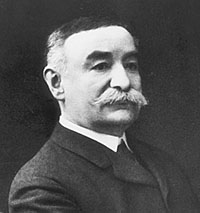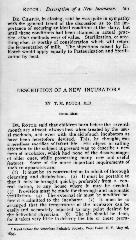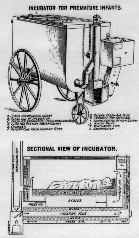
Description of a New Incubator
By T. M. Rotch, MD, Boston, Massachusetts.
[Thomas Morgan Rotch, 1849-1914]
Read before the American Pediatric Society, West Point, New York,
May 26, 1893.
Published in Archives of Pediatrics 10:661-665, 1893.

|
The first page of the original Rotch paper. |
Dr. Rotch said that children born before the seventh month are almost always lost when treated by the usual methods, and even with the aid of such incubators as have been heretofore devised. This, he thought, was a needless sacrifice of infant life. His object in calling attention to the subject at present was to describe a new form of incubator, which had none of the disadvantages of older ones, while possessing many new and useful features. Some of the more important requirements of such an apparatus are:
(1) It must be so constructed as to admit of thorough cleansing and disinfection.
(2) It must be portable so that it may be brought quickly, preferably from a central station, to any house where it may be needed.
(3) Provision must be made for thorough and automatic ventilation.
(4) The external air must be modified before it is admitted to the incubator.
(5) lt must be so arranged that the temperature of the incubator can be easily and accurately adjusted to any point desired by the individual physician.
(6) The air should be clean, for it takes very little to destroy the life of these premature infants.
(7) As in these children, there is often considerable pulmonary atalectasis, it is desirable that provisions be made for increasing, when desired, the proportion of oxygen in the air admitted to the incubator.
(8) As one of the best danger signals is lost [sic] of weight of the infant, the construction of the apparatus should be such as to admit of determining at any time the weight of the baby without exhausting it, as is invariably the case by the usual method of weighing.
To Mr. John P. Putnam of Boston, is due the credit of planning this incubator and Mr. Gordon, of the milk laboratory in Boston, has assisted me greatly in devising the mechanical means for carrying out my ideas. The incubator is constructed of polished copper, and is placed on wheels so that it may be moved about easily. This is a small but not an unimportant detail, for the mother naturally insists upon frequently looking at the child to see how it is doing, and by this arrangement her wish may be gratified without disturbing or injuring it.
The entire apparatus being constructed of metal, it can be easily and effectively cleansed and sterilized, thus avoiding any danger of carrying infection from house to house.
Former incubators have been particularly defective in the arrangement of the ventilation, so that the constant watchfulness of a nurse, day and night, was necessary to insure the occupant of the incubator against death by suffocation. In the new machine, the ventilation is kept up by an apparatus run either by clockwork or by heat in the ventilating flue. At the top of this flue there is a little fan or anemometer which shows to the attendant at a glance whether or not the ventilating apparatus is working properly. Before the external air is allowed to enter the incubator, it is thoroughly filtered through cotton so as to free it from impurities.
The baby is heated by radiation from all sides, and the bed on which it lies is a beautifully constructed balance, so that at will the weight of the baby can be ascertained at any moment. A tube connected with the incubator admits of adding oxygen to the air. A sort of rubber curtain is attached to the incubator, so that when the attendant is feeding the baby, or making necessary changes in the interior of the apparatus, the communication between the incubator and the external air is reduced to a minimum.
The excreta are passed into cotton, which is changed once a day. It is also very important to exactly modify the milk so that it may be adapted to the very feeble digestive powers of the premature infant. The incubator already constructed presents a very handsome appearance, and forms a part of the Harvard exhibit at the World's Fair. It weighs about one hundred and fifty pounds.

|
Diagram of the new incubator. Click here to view the full-size figure, then click the "Back" button in your Web browser to return to this page. |
Dr. Holt said he could testify to the very unsatisfactory working of the ordinary incubators heated by hot water bottles.